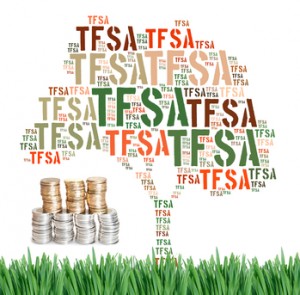By TSI Network and Jonathan Chevreau
TFSAs let you earn investment income—including interest, dividends and capital gains—tax free.
The federal government first made the Tax-free Savings Account (TFSA) available to Canadian investors in January 2009. These accounts let you earn investment income — including interest, dividends and capital gains — tax free. You could contribute $5,000 in 2009 to start your Tax-free Savings Account.
Every year until 2013, you could contribute an additional $5,000 to your TFSA. If you contribute less than the maximum to your TFSA in any given year, you can carry the difference forward. That means your TFSA contributions for 2009 and 2010 totalled $10,000, rising to $15,000 in 2011, $20,000 in 2012 and so on.
As of January 1, 2013 the annual contribution limit increased to $5,500, in line with the initial promise to adjust limits with rising inflation. It remains at $5,500 for 2015. That means that if you haven’t contributed yet (and were 18 years or older in 2009) you can now contribute up to $36,500. At some point, once the federal books are balanced, the Conservative government is on record that it will boost the annual TFSA limit to $10,000.
 How to shelter your gains with a Tax-free Savings Account
How to shelter your gains with a Tax-free Savings Account
Use your TFSA to complement your RRSP.
Generally speaking, your TFSA can hold the same investments as an RRSP. This includes cash, mutual funds, publicly traded stocks, GICs and bonds.
Contributions are not tax deductible, as they are with an RRSP. However, unlike withdrawals from RRSPs (or withdrawals for RRIFs to which most RRSPs are converted), withdrawals from a TFSA are not taxed. In this respect, RRSPs and TFSAs are mirror images of each other in the way they impact your taxes.
This makes the TFSA a good vehicle for more short-term savings goals, like saving up for a down payment on a first home. If funds are limited, you may need to choose between RRSP and TFSA contributions. RRSPs may be the better choice in years of high income when you’re in the top tax brackets, since RRSP contributions are deductible from your taxable income. In years of low or no income — such as when you’re in school, beginning your career or between jobs — TFSAs may be the better choice.
Investing in a TFSA in low-income years will provide a real benefit in retirement. When you’re retired, you can draw down your TFSA first, incurring zero tax liabilities. After that, you can begin making taxable RRSP withdrawals.
Hold low-risk investments in your TFSA.
 We think you are best to hold lower-risk investments in your TFSA. That’s because you don’t want to suffer big losses in these accounts. If you do, you can’t use those losses to offset capital gains, as is the case with taxable (non-registered) accounts. You’ll also lose the main advantage of a TFSA: sheltering gains from tax. You won’t have gains to shelter if the value of your investments falls.
We think you are best to hold lower-risk investments in your TFSA. That’s because you don’t want to suffer big losses in these accounts. If you do, you can’t use those losses to offset capital gains, as is the case with taxable (non-registered) accounts. You’ll also lose the main advantage of a TFSA: sheltering gains from tax. You won’t have gains to shelter if the value of your investments falls.
You can hold U.S. stocks in your TFSA, but Canadian shareholders pay a 15% withholding tax on dividends from U.S. stocks. In most cases, if you hold the stocks outside your RRSP, you can get a Canadian income tax credit to offset that tax. If you hold U.S. or foreign stocks in an RRSP, the withholding tax doesn’t apply. However, note that if you hold U.S. stocks in a TFSA, you can’t get back the withholding tax.
If you are just starting a TFSA, you likely won’t have enough funds to build a diversified portfolio within these accounts. That’s why you are best to hold lower-risk and low-fee equity investments. These include interest-bearing investments, like high-yield savings accounts such as those from President’s Choice Financial or Tangerine; or exchange-traded funds (ETFs), which provide instant diversification.
Two ETFs well-suited for TFSAs
ETF units trade on the Toronto exchange, just like stocks. Prices are quoted in newspaper stock tables and online. You’ll have to pay brokerage commissions to buy and sell them, but you will quickly make these back because of their low Management Expense Ratios – low, relative to the MERs charged on actively managed retail mutual funds.
1) iShares Core S&P/TSX Capped Composite Index ETF (Toronto symbol XIC) is a more diversified and lower-cost alternative than the older and more popular iShares S&P/TSX 60 Index ETF (XIU). XIC’s management fee is 0.05% and it provides exposure to some 250 stocks.
XIC’s top 10 holdings are Royal Bank, 6.3%; TD Bank 5.6%; Bank of Nova Scotia, 4.4%; CN Railway, 3.6%; Suncor Energy, 2.9%; BMO, 2.9%; Valeant Pharmaceuticals, 2.8%; Enbridge Inc., 2.8%; BCE, 2.4%; Manulife Financial, 2.3%.
iShares Core S&P/TSX Capped Composite Index ETF is a buy.
2) iShares Canadian Select Dividend Index ETF (Toronto symbol XDV) holds 30 of the highest-yielding Canadian stocks. Its selections are based on dividend growth, yield and payout ratio. The fund’s MER is 0.55%, and it yields 4.2%.
The ETF’s top holdings are CIBC, 7.3%; TD Bank, 6.8%, National Bank, 6.7%; Bank of Montreal, 6.1%; Royal Bank, 5.5%; BCE, 4.8%; Ag Growth International, 4.6%; Bank of Nova Scotia, 4.5%; Bonterra Energy, 4.2%; and Laurentian Bank of Canada, 3.9%.
The ETF holds 55.2% of its assets in financial stocks. The top Canadian finance stocks have sound prospects. However, if you invest in this ETF, be sure to adjust the rest of your portfolio so it won’t be overly concentrated in the financial sector.
iShares Canadian Select Dividend Index ETF is a buy.
Consider switching into individual stocks as your TFSA grows.
Over the years, as the value of your TFSA increases, you could switch to a well-diversified portfolio of conservative, mostly dividend-paying stocks. Here are three we recommend:
1) Canadian National Railway (Toronto symbol CNR) operates Canada’s largest railway. Its 32,350-kilometre network stretches across the country and through the U.S. Midwest to the Gulf of Mexico.
CN Rail has several key advantages that put it in a strong position to profit from an improving North American economy.
For example, it’s the only railway that accesses all three coasts: Atlantic, Pacific and the Gulf of Mexico. As well, CN owns an exclusive line that lets it avoid major bottlenecks in the Chicago area.
To top it off, lower fuel costs will enhance CN’s industry-leading efficiency rates. Crude-by-rail and fracking sand volumes should also remain steady, even with recent oil price drop.
CN Rail is a buy.
2) Toronto Dominion Bank (Toronto symbol TD) is Canada’s largest bank, with $921.8 billion of assets.
TD Bank also stands to gain from an improving North American economy, particularly in the U.S., where it now has more branches than in Canada.
At the same time, the low Canadian dollar will enhance the bank’s U.S. profits. TD’s strong emphasis on customer service will also help it hang on to depositors if interest rates rise. As well, lower oil prices should give consumers more cash to repay their loans, cutting TD’s loan losses.
TD Bank is a buy.
3) TransCanada Corp. (Toronto symbol TRP) operates a 68,500-kilometre pipeline network that pumps natural gas from Alberta to Eastern Canada and the U.S. The company’s pipelines supply 20% of North America’s natural gas
TransCanada could get a boost if it receives approval for two major pipelines that would pump crude oil from Alberta’s oil sands to the U.S. Gulf Coast (Keystone XL) and to refineries in Eastern Canada (Energy East).
Even if it has to abandon these projects, TransCanada’s crude volumes should remain steady, despite lower oil prices.
As well, the company could unlock some of its value by transferring assets to partly controlled affiliates. These transactions, called “drop downs,” help the parent company free up cash for new projects. Activist investors could also pressure TransCanada to spin off its electrical-power operations as a separate firm.
TransCanada is a buy.
Try The Successful Investor and get Findependence Day free
 The above article is a joint venture between TSI Network and the Financial Independence Hub. TSI Network is making the following Special Offer for Hub Readers:
The above article is a joint venture between TSI Network and the Financial Independence Hub. TSI Network is making the following Special Offer for Hub Readers:
Try out Pat McKeough’s flagship advisory, The Successful Investor, and get a free copy of Findependence Day (Canadian edition).
For more details, click link below:
Build Real Wealth With your TFSA.



As a retired Snowbird, I believe TFSAs are not a bad place to hold US Dividend paying stocks since the 15% US withholding tax is likely lower than the Canadian income tax payable from holding them in non-registered accounts.